Cover image from Magic: The Gathering X RockLove Collection
From the beginning, jewelry has held an important role in the lore of Magic: The Gathering. Over half the famous Power Nine from Limited Edition Alpha were gems set in jewelry, the famous Mox cycle (Pearl, Sapphire, Jet, Ruby, Emerald). The most iconic card of Commander, Sol Ring, has had many jewelry-adjacent representations, among them neck adornments, a possible bracelet or anklet, and wedding band–like forms.
There are plenty of examples of Magic cards being turned into real-life jewelry, both official (Magic: The Gathering X RockLove) and unofficial (the work of Olivia Gobert-Hicks). What about the reverse: a jewelry designer creating card illustrations? Design drawings are an essential part of the creative process for many jewelry creators, whether for themselves or for clients, and have been for centuries; among my favorite early 20th century examples are the drawings of Alma Pihl, a designer for Fabergé who created a series of exquisite snowflake– and ice-inspired designs, including one of the legendary Fabergé eggs, appropriately titled “Winter.”
Video by the Victoria and Albert Museum
While the often-austere style of jewelry design drawings is an imperfect fit with main-line Magic: The Gathering illustration, it would fit seamlessly within the wide spectrum of Secret Lairs. So what might a Secret Lair: Jewelry look like? Which designers, which cards, which styles? Taking a “sky’s the limit” approach, here are a few potential visions.
Allison Cimino of RockLove
The obvious place to start is with the woman already making official jewelry for Magic. Allison Cimino is CEO and Jeweler of RockLove, which has grown from a one-woman, one-apartment operation in New York City to a global enterprise deeply entwined with some of the most powerful media corporations in the world.
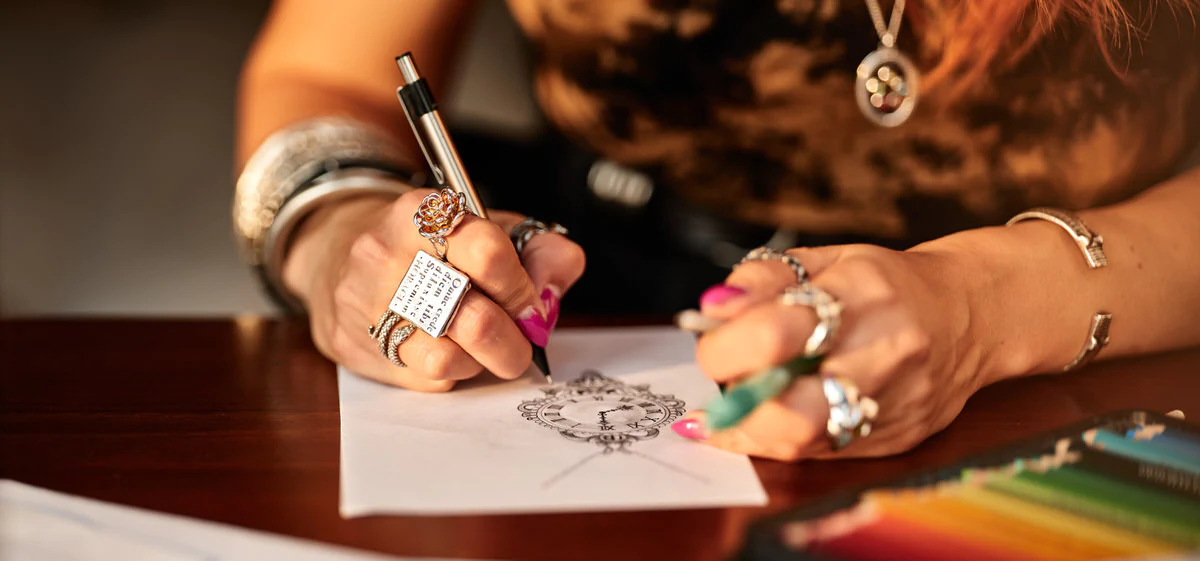
Allison Cimino sketching a design, from RockLove.com
Allison Cimino’s promotional images place her in the act of drawing, and the RockLove blog post about the Magic: The Gathering collection reveals how Magic: The Gathering’s art was a formative influence on her: “Already intent on becoming an artist, with a preference for fantasy illustration, I dreamed about someday having my own work printed as a Magic Card.”
Give her a longlist of powerful Secret Lair-worthy cards, let her go to town on the designs that catch her imagination, and follow it up with a line of sterling silver renditions in the Magic: The Gathering X RockLove line. This one’s such a no-brainer, it hurts.
Michelle Ong of Carnet
Hong Kong is a global crossroads of culture, money, and power. In a city where skyscrapers glitter like gems, it can be hard to stand out in the jewelry scene—unless you’re Michelle Ong of Carnet. Extravagant meets exquisite on bold brooches and remarkable rings where the supporting stones would be star players in most other designers’ creations.
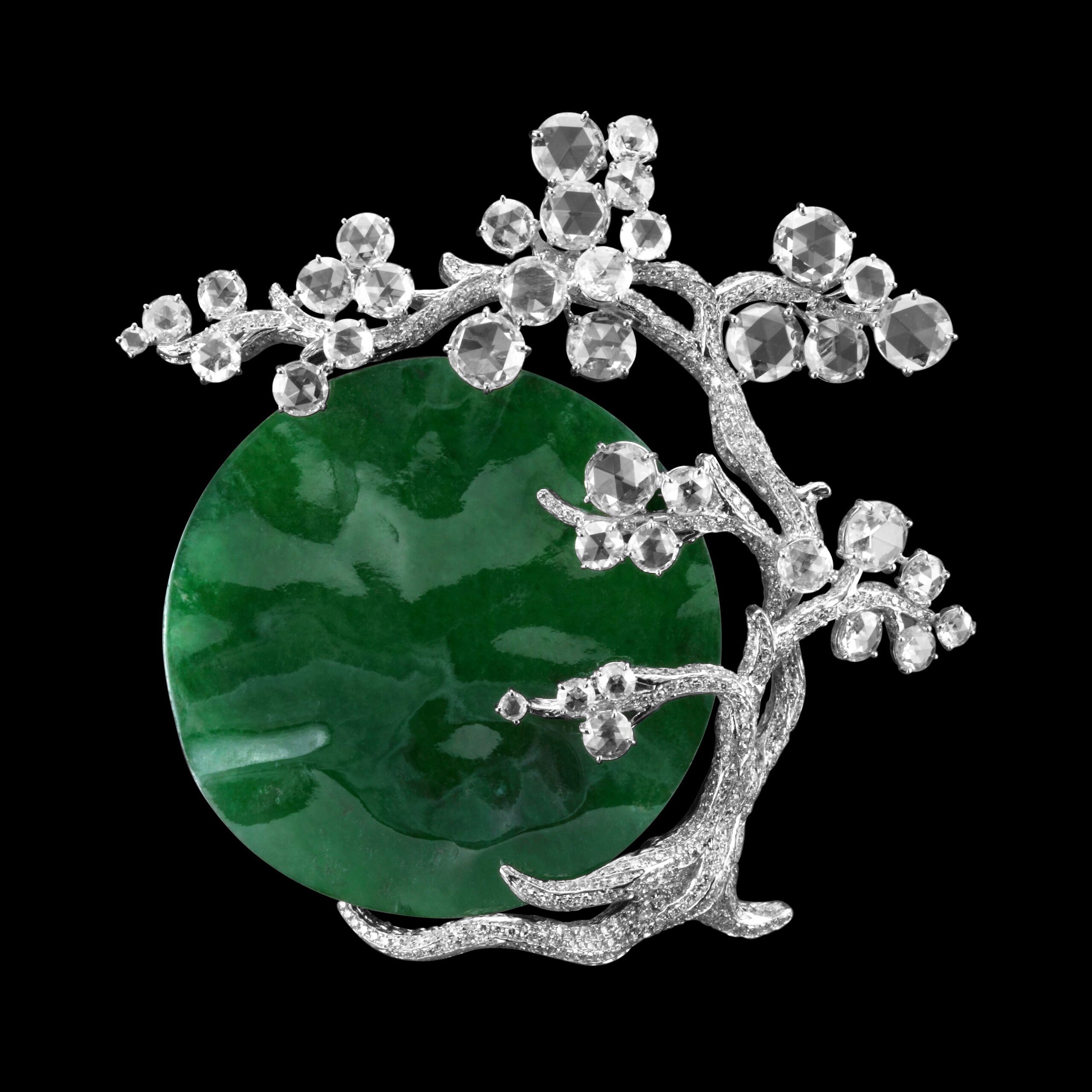
The Jade Embrace brooch designed by Michelle Ong, from CarnetJewellery.com
The Carnet tendency to embrace huge stones has me thinking of the Sky Diamond cycle, especially since the names—Marble, Charcoal, Fire, Moss—allow for natural and even organic inspirations. Alternatively, the Pearl Medallion cycle would provide a showcase for Michelle Ong’s stunning necklace designs. The trick will be finding cards that “go big” in a way that matches Carnet’s vision. Small and dainty just won’t do.
Azza Fahmy
Before Azza Fahmy founded the design house that bears her name, she was a young woman—at the time, the only young woman—learning to make jewelry in a workshop at the goldsmiths’ souq of Khan el-Khalili in Cairo, Egypt. Those skills and her vision and inspirations, from Arabic calligraphy to the ancient civilizations of Nubia, now appear in boutiques on four continents.
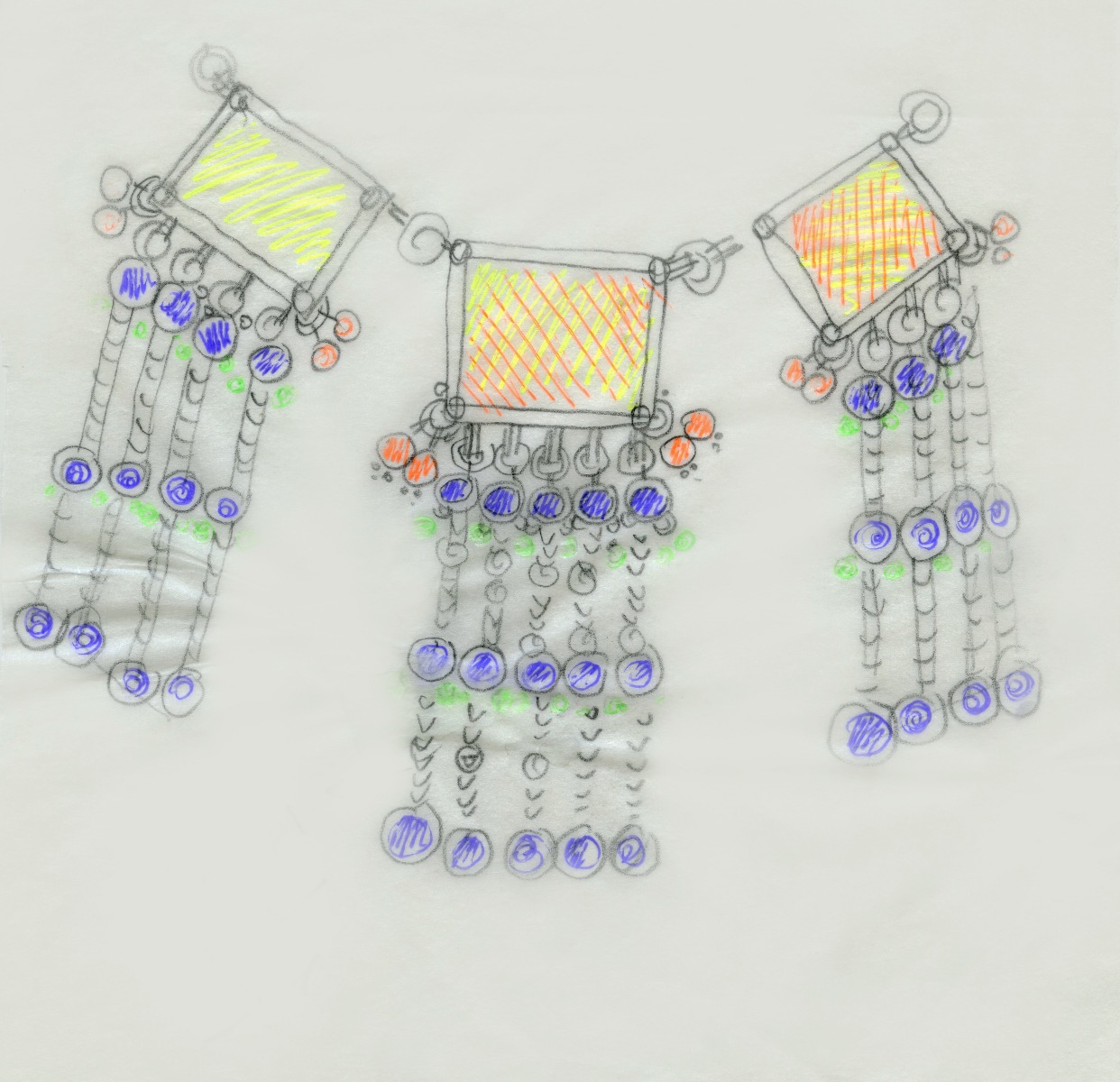
Drawing of a necklace from the Bedouin Collection by Azza Fahmy, from AzzaFahmy.com
Amulets have a long tradition in Egyptian culture, and would make an excellent fit with Azza Fahmy for a jewelry-themed Secret Lair. Traveler’s Amulet is an obvious choice, and Wayfarer’s Bauble might work well too. The Talisman of Unity cycle, in whole or part, would also allow the fullness of an Azza Fahmy design to come through.
Hancocks
Across the Burlington Arcade and a few doors down from its Azza Fahmy boutique is one of London’s most venerable jewelry firms, Hancocks. Offering a mix of high-end vintage jewelry and its own designs, Hancocks is most famous for a military medal – it is the maker of the United Kingdom’s highest military honor, the Victoria Cross.
Video by Hancocks
Hancocks has a long tradition of making signet rings. While the Magic card Arcane Signet usually has been depicted as a signet ring, the Ravnica cycle of Signets (Azorius Signet and friends) have not; Dan Frazier’s Secret Lair versions depict the signets as necklaces or pendants rather than rings. Gem-set signet rings in white gold would pair exquisitely with designs carved into blue lapis lazuli for the Azorius, black onyx for the Orzhov, and red carnelian for the Boros. Hancocks’ preferred variation of sardonyx, which presents as pale blue and cuts away to reveal a layer of black, would fit the Dimir flawlessly.
Silvia Furmanovich
A Brazilian designer of Italian descent, daughter of a goldsmith, Silvia Furmanovich launched her jewelry business in the late 1990s. Since then, she’s developed a reputation for bold designs and intriguing collections that pair unusual materials with the usual precious metals and gems. Her Bamboo collection, for instance, uses Japanese techniques with Brazil-grown bamboo, while her Marquetry collection incorporates wood veneer patterns rendered in genuine Brazilian woods (sustainably harvested, the website is quick to assure).
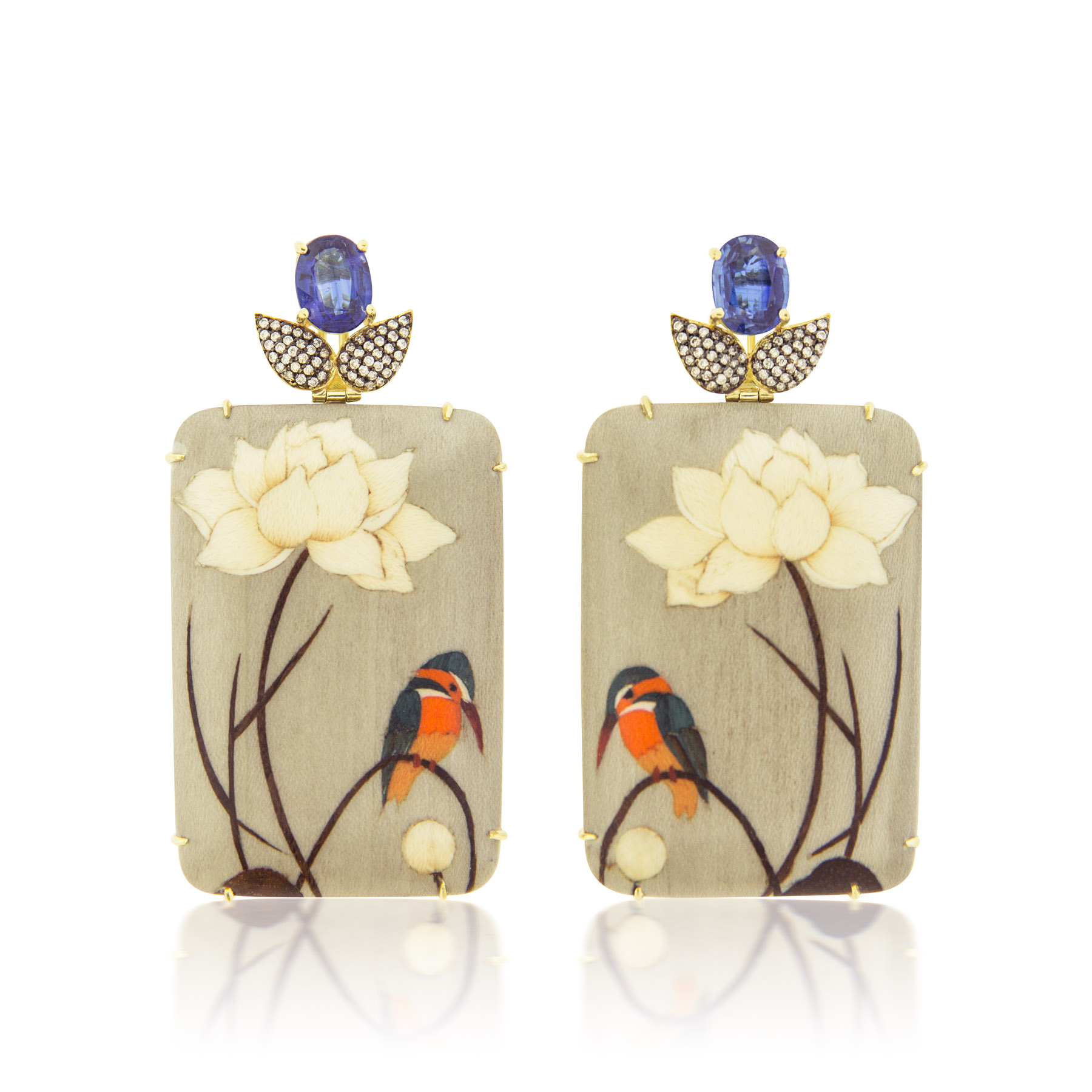
Bird flower earrings, from SilviaFurmanovich.com
The sheer range of materials used by Silvia Furmanovich opens an incredible range of possibilities. The Talisman cycle, for instance, could shift from natural materials for Selesnya (white and green) to industrial inspirations for Rakdos (red and black) and opulent gemstones for Orzhov (black and white). A Wayfarer’s Bauble could contain bits from the wayfarer’s varied travels. The list could go on and on.
Andrew McGregor of Carved In Jade
Pounamu is, broadly speaking, Māori jade. The Māori are the most numerous of the Polynesian peoples, found mostly in Aotearoa, aka New Zealand. Before Europeans arrived, the Māori used pounamu to make tools, weapons, and ornamental objects, and pounamu pendants and other jewelry remain a vital part of Māori culture. Andrew McGregor, founder of Carved In Jade, is a New Zealand designer who draws inspiration from both the Māori aspect of his ancestry (he is of partial Ngāi Tahu descent) and the European, particularly Celts and Vikings. This yields combinations such as a manaia, a Māori form, inscribed with a Celtic triquetra figure.
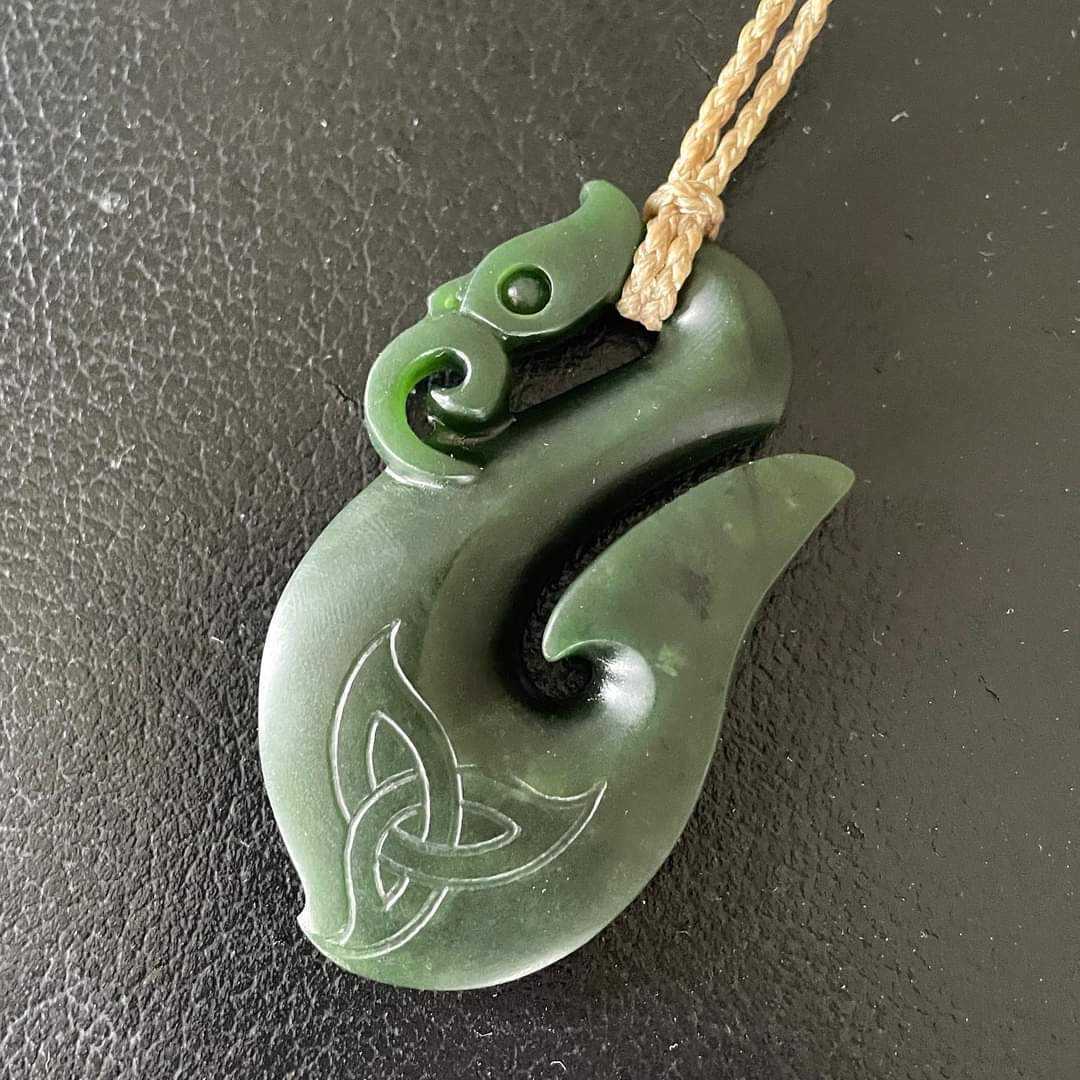
Manaia pendant with Celtic triquetra, from Carved In Jade’s Facebook page
The affinity for Celtic and Viking themes immediately brings to mind the Celtic-inspired Lorwyn / Shadowmoor and Norse-inspired Kaldheim. While the Kaldheim set is short on suitable artifacts, Weathered Runestone perhaps excepted, a Cauldron of Souls or Moonglove Extract vessel rendered in jade might work well. Jade also calls to mind its heavy use in Ixalan block, as on Traveler’s Amulet and the less-felicitously-named Primal Amulet and Sentinel Totem.
Chari Cuthbert of BYCHARI
Chari Cuthbert’s BYCHARI celebrates its ten-year anniversary in 2022. Cuthbert, a self-taught designer of Jamaican descent, credits her grandmother with inspiring her love of jewelry. Starting from just $100 and minimal business experience after moving to Hawaii, she built a line of (mostly) women’s jewelry that proves “the basics” can be anything but basic. Kate Hudson was an important early client, but it was a literal statement necklace, the “VOTE” necklace worn by former First Lady Michelle Obama for a televised speech at the 2020 Democratic National Convention, that instantly put BYCHARI into the national (and, thanks to the Internet, global) conversation.
Michelle Obama’s necklace spelled V-O-T-E. https://t.co/uwwgGSj03G
— USA TODAY (@USATODAY) August 18, 2020
Among recent BYCHARI offerings, two stand out: the Coco Collection, dripping with baroque freshwater pearls, and Something Blue, where rose-cut blue sapphires stand out in solitaire settings. Pearl Medallion and Sapphire Medallion are the obvious directions, but that’s only the beginning. How would Chari Cuthbert interpret Jinxed Ring, or Jinxed Choker? What sort of jewelry spin could she put on Rings of Brighthearth? And Pendant of Prosperity would be highly appropriate, given how her fortunes are on the rise.
Matthew Charley
Among the world’s most famous Indigenous jewelry traditions is that of the Diné people of the Navajo Nation. Their silver and turquoise jewelry are instantly recognizable and powerfully evocative. Among the most intriguing young Diné designers is Matthew Charley. A fifth-generation Diné jeweler active since 2010, Matthew Charley has already won prizes for pieces that combine a deep respect for tradition with personal innovations, such as a necklace that pairs the naja symbol and Bisbee turquoise with gold and diamonds. Among his best-known and most visible works is the crown worn by Miss Navajo Nation.
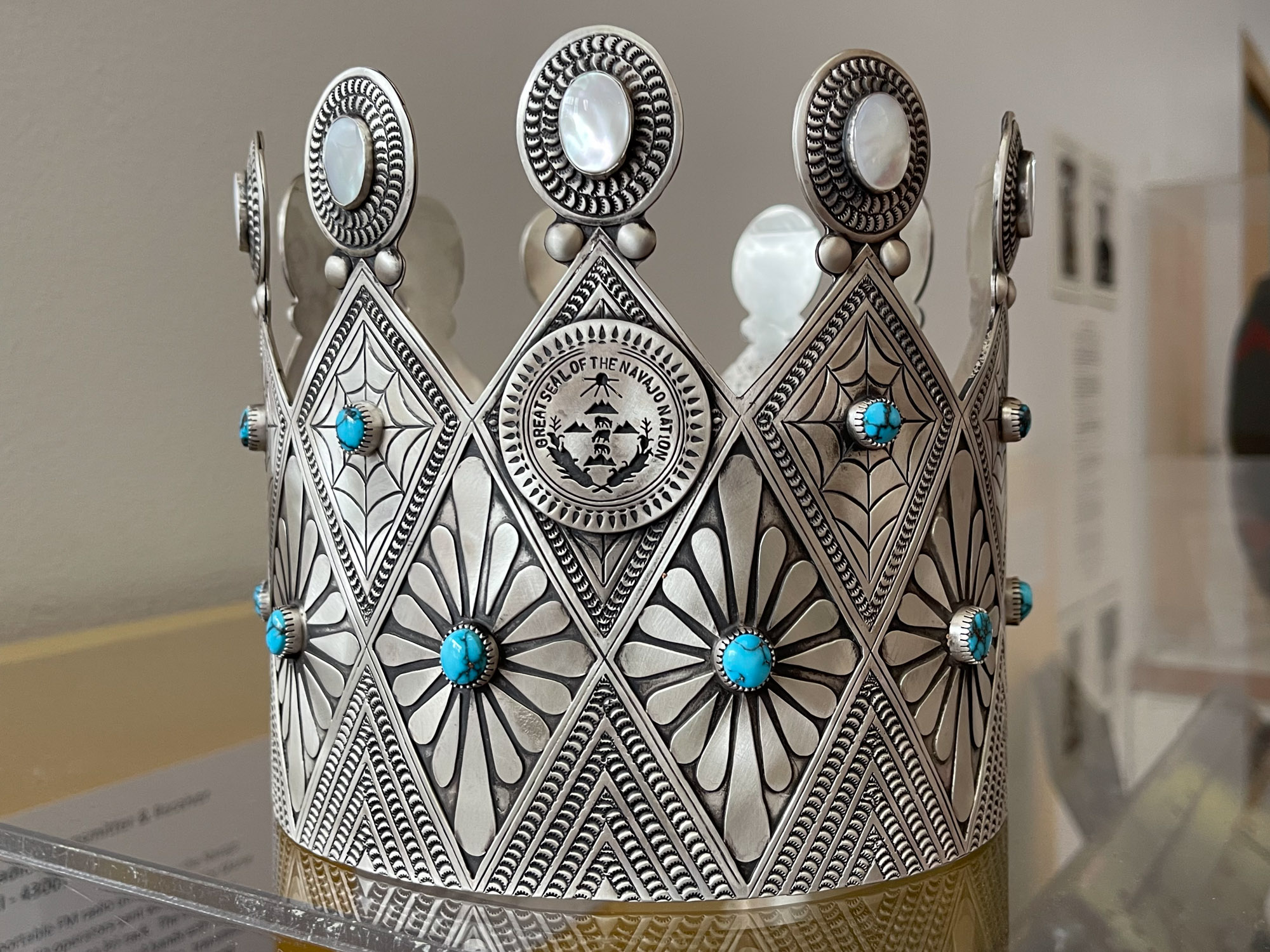
The crown of Miss Navajo Nation, from MatthewCharley.com
Matthew Charley’s signature technique is his stamp work, which creates intricate and exquisite patterns in metal. Between that and his pieces which act as complements to leather (keychains, hat bands, bolo ties, belts, etc.), it makes one wish that Jandor’s Saddlebags was a better card. Adventuring Gear is another possibility along those lines. Beyond leather-and-metal items, his incredible rings and pendants offer many of the possibilities listed for previous artists.
Jacob Arabo of Jacob & Co.
This list ends where it began: New York City, by way of the former Soviet Union. Jacob Arabo, born Yakov Arabov, had a fascination with watches and jewelry from childhood. When his family struggled after immigrating to the United States in the late 1970s, he dropped out to learn the trade. He opened his own company at 21, and in the 1990s, customer Christopher Wallace (aka The Notorious B.I.G.) nicknamed him “Jacob the Jeweler.” By that name, or simply “Jacob,” he became as omnipresent in hip-hop and R&B stars’ lyrics as on their bodies. Despite legal setbacks, the rise of other jewelers, and changing times, he remains a relevant sign of success.
Video by Jacob & Co.
Though he first gained fame as “Jacob the Jeweler,” Jacob Arabo never lost his fascination with watches and timepieces, and the results have been jaw-dropping. His Astronomia collection is already a series of stylized orreries that fit on a wrist. What could he do with Vedalken Orrery, or the Sol Ring-as-device idea seen on Mark Tedin’s Commander promo card? And what other cards could he encrust with gems?
So Many More
Those nine jeweler-artists are only the beginning of the possibilities for such a Secret Lair. One artist per non-North American continent just isn’t enough to showcase the incredible variety out there. How would a South Asian designer, working in one of the region’s several filigree traditions, reimagine Aetherworks Marvel or Panharmonicon? Or remember the Secret Lair: Black Is Magic Sol Ring with its Maasai-inspired neck ornament; that points the way toward a variety of African beading traditions. I said the sky’s the limit before, and I truly mean it.
Clearly, there’s no shortage of jewelry artists who could make drawings for a Secret Lair—or make the jewelry itself and photograph it. But Magic’s rich history of three-dimensional art rendered in two dimensions on Magic cards is a story for another article, and one we’ll hopefully dig into very soon.

